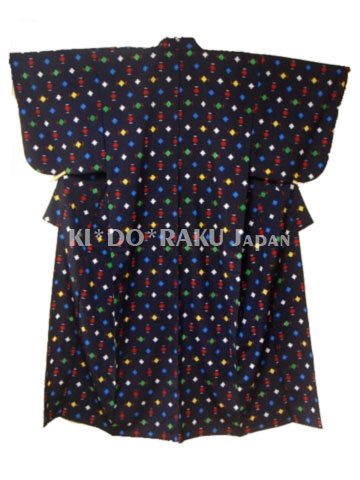With this I'm treading on thin ice. I am not a textile historian or know textiles extensively, but I'm trying my best to open the kimono fabrics a little. Please understand this. Later today or tomorrow morning, I'll talk about kimono patterns.
Kimono Fabrics
Natural fabrics are the normally used kimono materials, but lately also synthetic materials are being used for example in odori kimonos, because they must endure lots and lots of use and washing. Silk and cotton are probably the most common ones you will come across when going kimono shopping. Wool seems to have come popular lately too.
 |
| Cotton yukata kimono. |
Cotton is used solely as a yukata material. Cotton is a breezy material with a lot of use. The fibers of a cotton fabrics soak moisture well without making the fabric feel wet, which is one thing that makes cotton a nice fabric to use. The thickness of cotton fibers can diverse greatly, the thinest, longest and shiniest fibers are made into the finest cotton fabrics such as Sea Island and Egyptian. Cotton can be loosely woven, thin fabric or thick, durable material. Cotton does have bad ripping qualities, you can rip it by hand quite easilly. Taking care of cotton is also easy as you can wash it in an ordinary washing machine.
 |
| Silk iromuji kimono. |
Silk is diversly used is formal wear and unformal wear depending on the pattern and the weave of the fabric. Silk fibers are gotten from the cocoon of the silkworm. Freshly made silk is very hard to rip by hand, it's only possible if the silk is sheer enough and you have the muscle of a bodybuilder. Sunlight makes silks brittle and silk curtains left in direct sunlight for a lenghty period will eventually be destroyed. Sunlight makes silks as stong as toilet paper. Silk has a nice shine in it as a fabric and it is breezy and pleasant fabric to wear. Water does not agree with silks and cleaning silks is nowadays recommended at dry cleaning. Also hard folds on silk fabrics tend to stay and are hard or even unironable from the fabric. Silk fabrics drape beautifully which is why they are used in evening dresses and blouses. Wearing silk kimono has it's drawbacks and being careful, but silk in itself has good qualities and the feeling of luxury that makes it all worth it.
 |
| Wool Kimono by Kidoraku Japan. |
Wool is a natural fiber, which we get from the sheep's fur. Wool kimonos are unformal and patterns mostly geometrical. Wool is classified in terms of finest hair/fur of the animal and it's used to make mixed fabrics. Wool can be used to name other hair/fur related fabrics such as mohair, alpaca, cashmir and angora. To my knowledge, wool kimono is sheep's fur. Wool fabrics can be very diverse in terms of thickness, texture of the fabric and weave. Wool feels nice to the touch, can be a little strechy and the fibers soak moisture better than cotton. Wool also is hard to ignite, which is why it's used in interior decoration. Cleaning wool is considered easy, but washing it needs low temperatures and in fine wool fabrics dry cleaning is recommended. Wool can be cleaned by brushing the dirt of the fabric with a proper brush. Wool is sensitive to sunlight, moths and bleach.
 |
| Linen kimono from the 60s by so-meru. |
Linen as a kimono material is mentioned in the Book of Kimono by Norio Yamanaka. I have to admit I have not seen a linen kimono being sold lately, but I have not been looking too closely lately. I cannot say where in formality a linen kimono would sit, but it's behind silk. As a natural fiber linen is collected from the flax plant's stem. Linen is a very breezy material and the fiber soaks moisture extremely well, so linen is a good material for warm climate. Linen has the bad quality of being easilly wrinkled, which is why there's often a bit of cottom mixed into the linen fabric to make it less easilly wrinkled. Linen is impossible to rip by hand. As a person who has tried this, I can say that my hands hurt before the fabric could rip.
 |
| Synthetic odori kimono. |
Synthetic materials are slowly gaining a foothold in kimonos, but they are considered unformal wear. Most synthetic kimonos are polyester mixed with some other fabric to give it little shine without losing the easiness of cleaning and maintenance. Komon kimono and odori kimono are the ones I've seen use synthetic fabrics. Depending on the weave of the fabric and the materials used to make the fabric, the breathability of the fabric can differ.
Other materials used in kimonos and traditional japanese clothes are bast, hemp and ramie.
Reference used:
ImmortalGeisha Forum
The Book of Kimono by Norio Yamanaka
Otavan Suuri Ompelukirja
so-meru





Nowadays, synthetic kimono is rather popular due to its cheaper price and easier cleaning procedure. I've already seen polyester yukata, polyester tsukesage and polyester furisode selling online :).
VastaaPoista